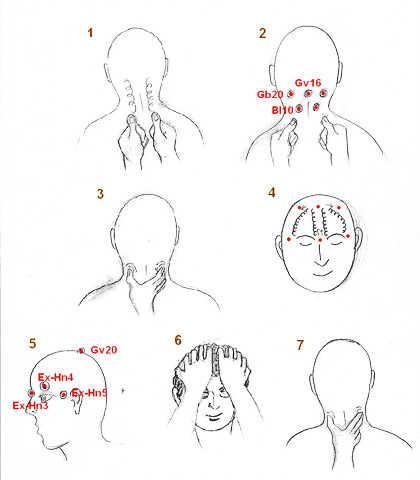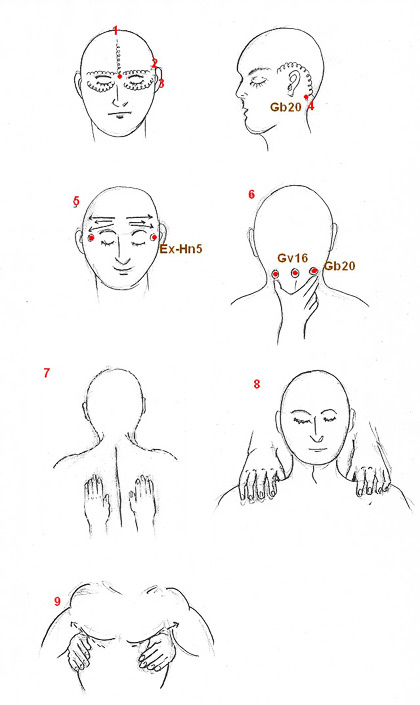|
The experience of headaches differs from person to person. Most people suffer from mild headaches once in a while, but there are people whose headaches occur repeatedly and last for a long time, completely disrupting their lives. Headache is only a symptom which can have many causes. Factors able to stimulate the blood vessels, nerves, or muscles surrounding the skull could trigger off headaches, while factors able to soothe these tissues are beneficial to headaches. Therefore, a number of non-medicinal methods are available to keep headaches under control, learning some of the techniques can help you better copy with headache attacks and less depend on pain medications.
In traditional Chinese medicine (TCM), the head is regarded as "the confluence of yang" and "the dwelling of lucid yang," which mean the head is closely connected with other parts of the body, and all the organs are responsible for nourishing it. The body has a giant web called the meridian system to supply the head with fundamental substances like essence, qi and blood. When the meridian system is dysfunctional, which causes obstruction of the head collaterals or under nourishment of the head orifices, headaches will occur. TCM therapeutic principle for headaches is to unblock the meridians and collaterals, and reactivate qi and blood. Apart from the routine approaches like acupuncture and herbal remedies, many non-medicinal methods are employed as auxiliary. They help reduce the frequency and severity of headaches, and improve the overall efficacy of headache treatment. TCM methods like massage, auricular stimulation, scraping and cupping are all non-medicinal approaches, which are simple and safe to apply. These treatment options are worth a try.
Chinese acupressure for headaches
This type of massage is based on the meridians. Massage therapists use the fingers to strike, press, knead and pinch the acupoints along the meridians, so as to produce local or general therapeutic effects. Chinese acupressure massage has been used to treat a wide range of diseases, among them bone and joint problems or painful conditions have the most satisfied results, others such as internal organ problems, gynecology, pediatrics, localized problems of the head can also be treated. Due to the influences from different academic sources, regional cultures and practical experiences, many different schools and branches were established in Chinese acupressure, which have contributed hundreds of bodywork techniques for clinical application. Below are the acupressure protocols for headaches.
Acupressure protocol for headaches (I)
Massage therapists mainly use the thumbs to apply pressure on the body surface. "Pushing with One-finger Meditation" is a common technique in Chinese massage; therapists uses the thumb to push and rotate forward along a meridian, the swing frequency is usually up to 120-160 times per minute, so that the pressure can acts on the selected region for some time.
| 1. |
Push with the thumbs, along the sides of the neck (the courses of the bladder meridians), back and forth for 3~4 minutes; |
| 2. |
Knead the acupoints on the upper neck, feng chi (Gb 20), feng fu (Gv 16) and tian zhu (Bl 10), 30 seconds each; |
| 3. |
Use one hand to grasp feng chi (Gb 20) on both sides, and then grasp along the sides of the neck, up and down for 4~5 times; |
| 4. |
Push with the thumbs, from the middle of eyebrows (Ex-Hn 3) up to the hairline (Gv 24), then push along the hairline to the hair corners (St 8), and then down to the temples (Ex-Hn 5), repeat the steps for 3~4 times; |
| 5. |
Knead the acupoints like yin tang (Ex-Hn 3), yu yao (Ex-Hn 3), tai yang (Ex-Hn 5) and bai hui (Gv 20), 30 seconds each; |
| 6. |
Comb and grasp the scalp with both hands, 2 minutes; |
| 7. |
Use the thumb, forefinger and middle finger to grasp along the neck, up and down for 4~5 times. |
 |
| Acupressure protocol for headaches (I) |
Acupressure protocol for headaches (II)
Use the thumbs to apply pressure on the body surface.
| 1. |
Push with the thumbs, from the middle of eyebrows (Ex-Hn3) up to the hairline (Gv 24); |
| 2. |
Push from the middle of eyebrows to the outer sides of the eyebrows (Sj 23); |
| 3. |
Push from the middle of eyebrows, along the lower orbital (St 2) to the outer corners of the eyes (Gb 1), and stop at the temples (Ex-Hn 5); |
| 4. |
Push from the temples to the back of the ears (Gb 6), and down to the base of the skull (Gb 20); |
| 5. |
Wipe the forehead, knead the temples (Ex-Hn 5), and then wipe along the back of the ears and down to the base of the skull (Gb 20); |
| 6. |
Grasp feng chi (Gb 20) on both sides, and then knead the middle point feng fu (Gv 16); |
| 7. |
Push the inter-scapular regions of the back (Bl 43); |
| 8. |
Grasp the middle of the shoulders (Gb 21); |
| 9. |
Rub the sides of the lower chest. |
During applications, the above steps are often modified according to individual conditions. For example, if the headache sufferer feels weak and dizzy, remind him close the eyes when doing the pushing techniques, while open the eyes when doing the wiping or grasping techniques. For headaches induced by common cold, it is advised applying the grasping techniques first, and then follow by pushing techniques.
 |
| Acupressure protocol for headaches (II) |
Click to see more acupressure techniques for headaches.
|